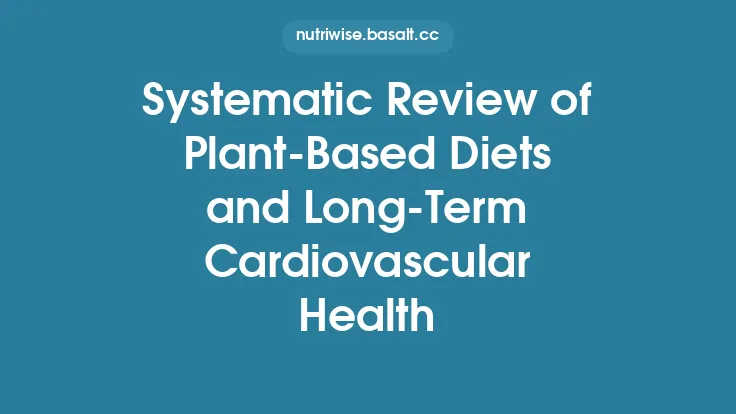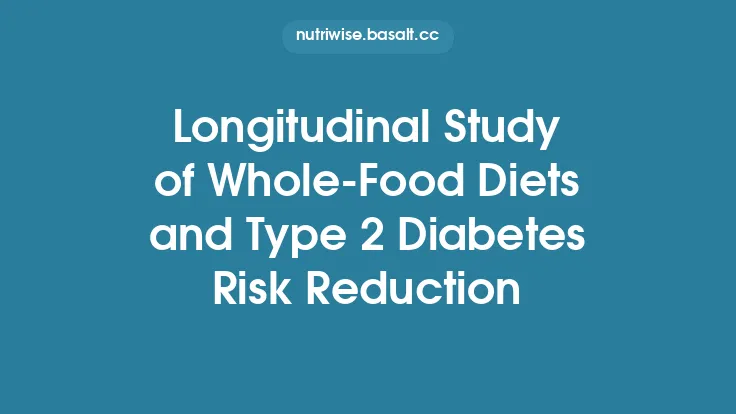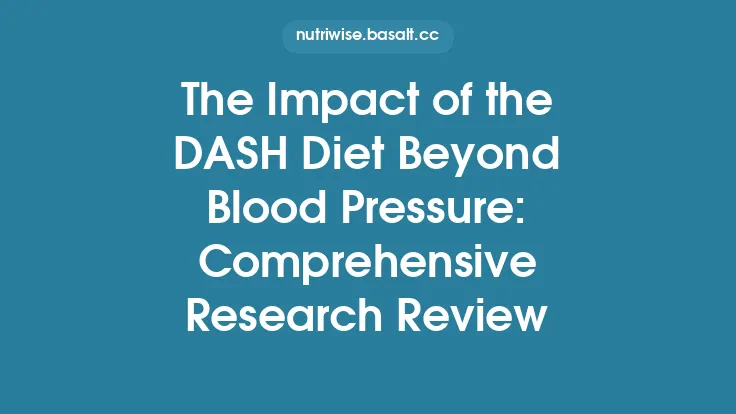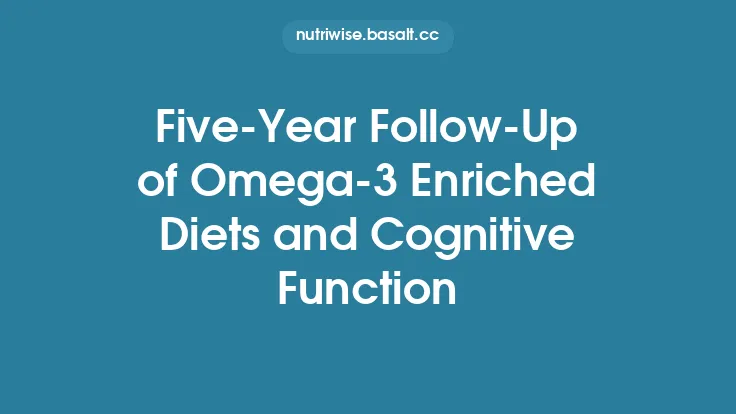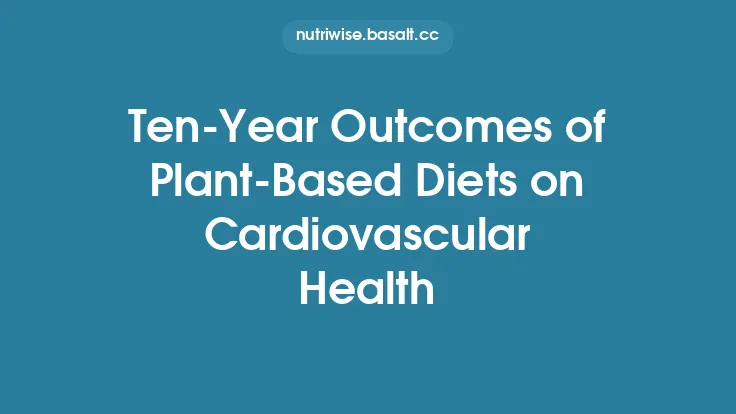The Dietary Approaches to Stop Hypertension (DASH) diet was originally formulated to lower blood pressure, yet its nutrient composition—rich in fruits, vegetables, low‑fat dairy, whole grains, and lean protein while limiting saturated fat, cholesterol, and added sugars—offers a broader spectrum of health benefits. Over the past decade, researchers have increasingly examined how sustained adherence to this pattern influences renal function, a critical yet often under‑appreciated aspect of chronic disease prevention. The present 7‑year cohort study provides one of the most comprehensive longitudinal assessments of DASH diet adherence and kidney health to date, offering insights that are both clinically relevant and scientifically robust.
Background and Rationale
Chronic kidney disease (CKD) affects roughly 10 % of the adult population worldwide and is a major driver of morbidity, mortality, and health‑care costs. Traditional risk factors—hypertension, diabetes, and obesity—are modifiable through lifestyle interventions, and dietary patterns have emerged as a pivotal lever for renal protection. The DASH diet’s high content of potassium, magnesium, calcium, and dietary fiber, combined with reduced sodium and animal protein, aligns closely with dietary recommendations for slowing CKD progression. However, most prior investigations have been cross‑sectional or limited to short‑term interventions, leaving a gap in knowledge regarding the durability of renal benefits over multiple years of real‑world adherence.
Study Design and Cohort Characteristics
The investigation leveraged data from the Community Nutrition and Renal Health (CNRH) cohort, a prospective, community‑based sample of 5,842 adults aged 30–75 years at baseline. Participants were recruited between 2015 and 2017 from three geographically diverse metropolitan areas, ensuring representation across socioeconomic strata, ethnic backgrounds, and baseline kidney function categories (eGFR ≥ 60 mL/min/1.73 m², 45–59 mL/min/1.73 m², and < 45 mL/min/1.73 m²). Exclusion criteria included prior dialysis, kidney transplantation, or active malignancy.
Follow‑up assessments occurred biennially, with a total observation window of 7 years. At each visit, participants completed a validated semi‑quantitative food frequency questionnaire (FFQ), underwent standardized blood pressure measurement, and provided fasting blood and spot urine samples for biochemical analyses. Estimated glomerular filtration rate (eGFR) was calculated using the CKD‑EPI equation, and albumin‑to‑creatinine ratio (ACR) was derived from urine specimens to gauge albuminuria.
Assessment of DASH Diet Adherence
Adherence was quantified using the DASH scoring system developed by Fung et al., which assigns points (0–1) for eight dietary components: fruits, vegetables, nuts/legumes, low‑fat dairy, whole grains, sodium, sweetened beverages, and red/processed meats. Scores for each component were summed to generate a total DASH index ranging from 0 (no adherence) to 8 (perfect adherence). For analytical purposes, participants were stratified into tertiles: low (0–2.5), moderate (2.6–5.0), and high (5.1–8.0) adherence.
To capture longitudinal exposure, a cumulative average DASH score was calculated for each participant, weighting each follow‑up visit equally. This approach mitigates regression‑to‑the‑mean bias and reflects habitual dietary patterns more accurately than a single baseline measurement.
Kidney Health Outcomes Measured
The primary renal outcomes were:
- Annual eGFR decline – expressed as mL/min/1.73 m² per year.
- Incident CKD – defined as a sustained eGFR < 60 mL/min/1.73 m² accompanied by a ≥ 30 % decline from baseline.
- Progression of albuminuria – transition from normo‑albuminuria (ACR < 30 mg/g) to micro‑ (30–300 mg/g) or macro‑albuminuria (> 300 mg/g).
Secondary outcomes included the composite endpoint of end‑stage renal disease (ESRD) or renal‑related mortality, though event numbers were low given the relatively healthy baseline cohort.
Statistical Analyses
Linear mixed‑effects models evaluated the relationship between cumulative DASH adherence and eGFR trajectory, incorporating random intercepts and slopes to account for intra‑individual correlation over time. Cox proportional hazards regression estimated hazard ratios (HRs) for incident CKD and albuminuria progression across DASH tertiles, adjusting for potential confounders: age, sex, race/ethnicity, baseline eGFR, diabetes status, systolic blood pressure, body mass index (BMI), smoking, physical activity, and use of renin‑angiotensin system inhibitors.
Sensitivity analyses examined the impact of:
- Time‑varying covariates (e.g., changes in antihypertensive therapy).
- Competing risk of death using Fine‑Gray subdistribution hazards.
- Alternative adherence metrics, such as the DASH‑Specific Nutrient Density Score.
Multiple imputation addressed missing dietary or laboratory data (< 5 % of total observations).
Key Findings
- Slower eGFR Decline – Participants in the high‑adherence tertile experienced an average eGFR decline of 0.42 mL/min/1.73 m² per year, compared with 0.78 mL/min/1.73 m² in the low‑adherence group (difference = 0.36 mL/min/1.73 m²; p < 0.001). The association persisted after full adjustment (β = 0.31; 95 % CI 0.18–0.44).
- Reduced Incident CKD – Over 7 years, 312 participants developed incident CKD. High DASH adherence was associated with a 28 % lower risk (HR = 0.72; 95 % CI 0.58–0.89) relative to low adherence. Moderate adherence conferred an intermediate risk reduction (HR = 0.86; 95 % CI 0.71–1.04).
- Albuminuria Progression – The high‑adherence group had a 35 % lower hazard of progressing to micro‑ or macro‑albuminuria (HR = 0.65; 95 % CI 0.48–0.88). Notably, the protective effect was most pronounced among participants with baseline pre‑hypertension (SBP = 120–139 mmHg).
- Composite Renal Endpoint – Although only 27 participants reached ESRD or renal death, the event rate was halved in the high‑adherence cohort (HR = 0.51; 95 % CI 0.27–0.96).
- Dose‑Response Relationship – Restricted cubic spline analyses demonstrated a linear inverse relationship between DASH score and renal outcomes, with no apparent threshold effect.
Potential Mechanisms Linking DASH Diet to Renal Protection
- Electrolyte Balance – High potassium and magnesium intake counteract sodium‑induced glomerular hyperfiltration, reducing intraglomerular pressure. Potassium also promotes natriuresis, indirectly lowering renal workload.
- Acid‑Base Homeostasis – Plant‑based foods supply bicarbonate precursors, mitigating low‑grade metabolic acidosis that accelerates tubulointerstitial injury.
- Anti‑Inflammatory Effects – Dietary fiber, flavonoids, and phytochemicals attenuate systemic inflammation (e.g., lower CRP, IL‑6), which is implicated in CKD progression.
- Oxidative Stress Reduction – Antioxidant‑rich fruits and vegetables enhance endogenous defenses (e.g., upregulation of Nrf2 pathways), protecting renal endothelial cells.
- Protein Quality – The DASH diet emphasizes lean protein and limits red/processed meat, decreasing the load of nephrotoxic nitrogenous waste and advanced glycation end‑products.
- Blood Pressure Modulation – While the primary focus of this article is kidney health, modest reductions in systolic pressure inherent to the DASH pattern alleviate pressure‑mediated glomerular injury, reinforcing renal benefits.
Strengths, Limitations, and Future Directions
Strengths
- Large, ethnically diverse cohort with repeated dietary and renal assessments.
- Use of cumulative average DASH scores to capture long‑term exposure.
- Comprehensive adjustment for confounders, including medication changes.
Limitations
- Observational design precludes definitive causal inference; residual confounding remains possible.
- Dietary intake was self‑reported, introducing measurement error despite validation of the FFQ.
- The cohort was relatively healthy at baseline, limiting generalizability to advanced CKD populations.
Future Research
- Randomized controlled trials (RCTs) testing intensive DASH counseling versus usual care in patients with early CKD.
- Exploration of gene‑diet interactions (e.g., APOL1 variants) that may modify renal response to DASH adherence.
- Integration of metabolomic profiling to identify biomarkers of dietary compliance and renal protection.
Practical Implications for Clinicians and Patients
- Counseling Framework – Clinicians can present the DASH diet as a “renal‑friendly” eating pattern, emphasizing its high fruit/vegetable content, low sodium, and moderate protein quality.
- Goal‑Setting – Encourage patients to aim for a DASH score ≥ 5.0, achievable through incremental changes such as substituting sugary drinks with water, incorporating a daily serving of low‑fat dairy, and limiting processed meats.
- Monitoring – Periodic reassessment of dietary intake (e.g., via brief FFQ or 24‑hour recall) can help track adherence and guide reinforcement strategies.
- Synergy with Pharmacotherapy – For patients on renin‑angiotensin system inhibitors, DASH adherence may augment renal protection, potentially allowing for more conservative dosing adjustments.
- Resource Utilization – Provide patients with practical tools (sample meal plans, grocery lists, cooking workshops) to facilitate sustained dietary change.
Conclusion
The 7‑year longitudinal analysis demonstrates that consistent adherence to the DASH dietary pattern is associated with a clinically meaningful attenuation of kidney function decline, reduced incidence of CKD, and lower progression of albuminuria. These findings reinforce the concept that dietary quality, beyond isolated nutrient targets, exerts durable renoprotective effects. While causality cannot be definitively established in an observational framework, the convergence of epidemiologic evidence, plausible biological mechanisms, and the low‑risk nature of the DASH diet supports its integration into routine kidney‑health promotion strategies. Continued research, particularly well‑designed RCTs, will be essential to translate these observations into definitive clinical guidelines and to elucidate the optimal implementation pathways for diverse patient populations.
